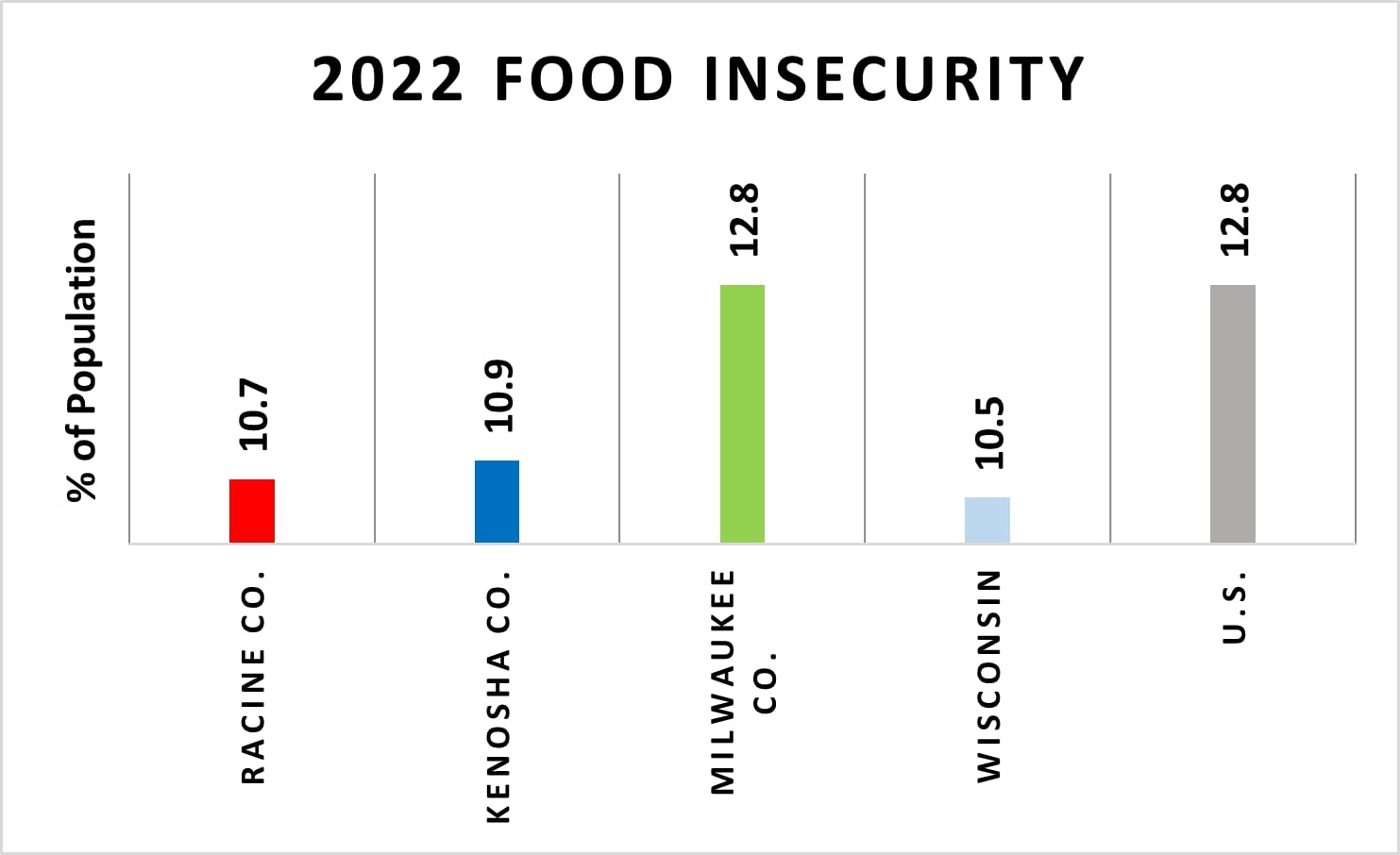Health Indicators Dashboard
-
The City of Racine Public Health Department has compiled data regarding current health status and other factors that impact the well being of Racine residents and visitors:
Mental Health and Substance Abuse
-
Economic Indicators
Racine’s economic success is the result of hard-working, talented people who are dedicated to creating a dynamic community. Lack of quality, affordable housing and well-paying jobs can hamper the City’s ability to attract new business and grow. Identifying opportunities to improve Racine’s job and housing situations can lead to a strong local economy that is able to withstand downturns. This section contains information about factors affecting Racine’s economy.
Access to Healthcare

Sources:
Medicaid, and Forward Health
Racine County has a higher rate of individuals enrolled in Medicaid compared to the state of Wisconsin and the United States. From the years 2019 to 2022, enrollment in all regions increased and then in year 2022 drastically decreased for all regions.

Source:
Centers for Medicare and Medicaid ServicesRacine County has a higher rate among the State of Wisconsin and the United States in people enrolled in Medicare. Between 2019 and 2023, there is a gradual increase in rates for the county, state and U.S. However, the U.S overall still increases but has a much lower rate compared to Wisconsin and Racine County.

Sources:
2020 Central Racine County Community Health Survey, Henry J Kaiser Family Foundation, U.S. Census Bureau, and Centers for Disease Control
In 2022, the City of Racine had approximately 93% of it’s residents covered by health insurance, an increase from 2018 which was at 90%. Overall, the City of Racine is coverage is lower than Racine County, the State of Wisconsin but higher than the National percentage of 91% for 2022. The general trend in all regions between 2018 and 2022 shows either plateauing or increasing in health care coverage for it’s recipients.
Residents Living in Poverty

Source:
U.S Census BureauPoverty level according to the U.S. Census Bureau, are dependent on income and family size. The City of Racine has had a significantly higher percentage of the total population living in poverty compared to Racine County, the State of Wisconsin and the U.S. However, in 2022, the City of Racine total poverty percent drastically dropped to the same level as Racine County, making it less than the national level.
Nutrition

Source:
2020 Racine County Community Health Survey Report23% of adults and 43% of children in the City of Racine reported eating the daily recommended amount of vegetables while 93% of children are eating their daily recommended amount of fruit servings. There is a significant portion of both the adult and child populations that are not consuming the suggested portions of fruits and vegetables.

Source:
County Health Rankings and RoadmapsRacine County has a lower percentage of people with limited access to healthy foods than Kenosha and the State of Wisconsin, with only Milwaukee County having better access. Having limited access to healthy foods means an individual is both living in poverty and does not live within one mile of a grocery store.

Source:
Racine County Food Bank, Racine Urban Garden Network, The Gardens Network, and Groundwork MilwaukeeCity of Racine has the least amount of community gardens available out of the Madison and Milwaukee. However, both of these cities have much larger populations, making the number of community gardens per resident much closer and on par.

Sources:
Food insecurity is defined as limited or uncertain access to affordable and nutritious food in sufficient quantity. This includes people who may not have the money to purchase food regularly and those who must decide to buy food or pay other expenses. In 2022, 10.7% of Racine County residents experienced food insecurity, which is comparable to the State of Wisconsin and the entire United States.
Supplemental Nutrition Assistance Program (SNAP, FoodShare) Enrollment

Sources:
U.S. Department of Agriculture, and Wisconsin Department of Health ServicesThe FoodShare (Wisconsin’s SNAP program) enrollment rate in Racine County has consistently been higher than both the State of Wisconsin and the United States. During 2022 and 2023, Racine county has stayed at a steady level.
Unemployment

Source:
U.S. Bureau of Labor StatisticsThe unemployment rate is approximately back to where it was pre-pandemic at nearly all levels with the county remaining higher than the state of Wisconsin and the United States.
Housing

Source:
U.S. Census BureauThe City of Racine has a smaller percentage of substandard housing compared to the State of Wisconsin and the United States. This means that almost every home in the City has appropriate plumbing and kitchen facilities.
Homelessness

Source:
HUD Homelessness Data ExchangeThe homeless rates in Racine County, State of Wisconsin and U.S dropped heavily during the year 2021, but started to increase at the same rate in 2023. The State of Wisconsin was the only one that had minimal change to their homeless rate over the past 5 years with minimal fluctuations.
Foreign-Born Non-Citizens

Sources:
U.S. Census Bureau, and Migration PolicyThe rate of foreign-born non-citizens is higher in the City of Racine than in both Racine County and the State of Wisconsin, but is lower than the Unites States. The rates in all locations have remained relatively steady.








